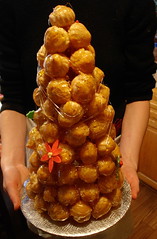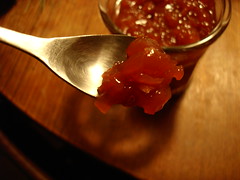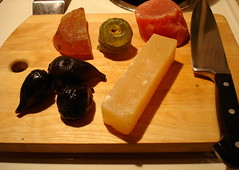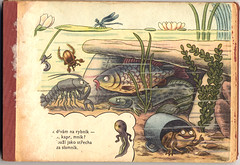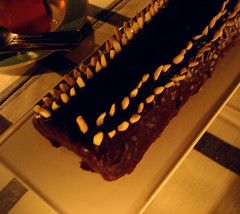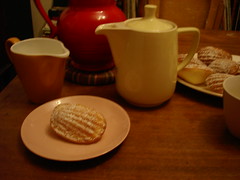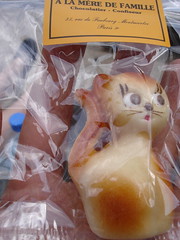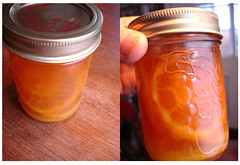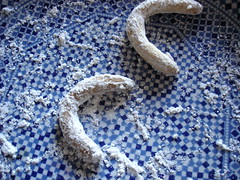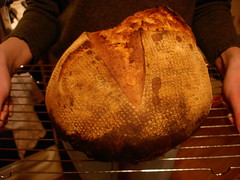I’m not sure what we did to deserve Kazi. Last week, she made us some amazing Vanilkoví Rohlicky (the description of which in these very pages [see “St. Nicholas Day”] apparently inspired others to make these little gems with similarly delicious results). This week, she had us, and a few others, over for her legendary Czech Duck. The Czech Duck tradition in Kazi’s family stretches back years and years, but within our group of friends it started about 2 years ago, when Kazi’s mother came out for a visit from Western Canada and the two of them decided to make traditional Czech fare for a group of Kazi’s friends. This tradition consists of a wonderful whole roasted duck (one which manages the impossible: tender and juicy on the inside, with a lovely crispy skin on the outside), sautéed red cabbage, hearty dumplings, and a rich gravy. Kazi deprecatingly refers to this meal as “just Czech pub food” (and as Michelle and I found out last year, such meals ARE common in pubs and brauhauses across Central and Eastern Europe), but that description doesn’t quite do it justice. This is a fine meal.
The tradition includes a lovely dessert, as well. The first year, we all nearly swooned over the sweet fruit dumplings that Kazi and her mother whipped up. This year, inspired by Michelle’s copy of Rick Rodgers’ Kaffeehaus, which she got a chance to leaf through a few weeks ago, Kazi attempted to pay homage to her grandmother by making Chocolate “Saddle of Venison” Cake. We told her she was crazy, that she was taking on too much (after all, she was going to be cooking solo this year), but secretly we were hoping she’d actually try it, because neither of us had ever had the legendary “Saddle of Venison," and because we knew full well that Kazi would manage to pull it off if she tried it. Well, the cake wasn’t exactly what Kazi had expected, it wasn't quite as perfect as Rick Rodgers' (she’s always her harshest critic), but let’s just say that we’re confident she made her grandmother proud. Here’s the recipe she used.
Chocolate “Saddle of Venison” Cake
a.k.a. Rehrücken
3 oz high-quality bittersweet chocolate, finely chopped
2/3 cup (2 oz) cake crumbs (you can use unfrosted vanilla- or chocolate-flavored cupcakes for these crumbs in a pinch)
1/2 cup (2 oz) sliced blanched almonds
1/4 tsp ground cinnamon
Zest of 1 lemon
4 large eggs, separated, at room temperature
1/2 cup sugar, divided
2 tablespoons unsalted butter, melted
1/3 cup Red Currant Glaze (see below), warm
Small-Batch Chocolate Glaze (see below), hot
1/2 cup (2 oz) slivered blanched almonds, as needed, for garnish
Special equipment needed: a Rehrücken mold (these can be found at well-stocked kitchenware shops—Kazi found hers at Arthur Quentin on St. Denis Blvd., here in Montreal)
Position a rack in the center of the oven and heat to 350º F. Using a cylinder-shaped pastry brush, butter a 12-inch Rehrücken mold. Dust with flour and tap out the excess.
Melt the chocolate in the top part of a double boiler over hot, not simmering, water, or in a microwave oven at medium power. Cool slightly.
In a food processor fitted with the metal blade, process the cake crumbs and almonds until the almonds are very finely ground and almost powdery. Add the cinnamon and lemon zest and pulse to combine.
Beat the yolks and 1/4 cup of the sugar in a medium bowl, using a handheld electric mixer at high speed, until thick and pale yellow, about 2 minutes. Mix in the melted chocolate and butter, then the almond-crumb mixture.
Using clean beaters, beat the egg whites on high speed until they form soft peaks. Gradually beat in the remaining 1/4 cup of sugar, until the whites are shiny. Stir one fourth of the whites into the chocolate batter to lighten it, then fold in the remaining whites. Pour into the pan.
Bake until a toothpick inserted in the center comes out clean, about 35 minutes. Cool in the pan on a wire rack for 5 minutes. (The cake will fall slightly—this is normal.) Invert onto the rack and cool completely (the cake will then even itself out).
Place the cake on the rack on a jelly-roll pan. Brush the cake with warm red currant glaze. Cool completely to set the glaze.
Pour the warm chocolate glaze over the cake, using a metal spatula to smooth it over the sides, coating the cake completely. Stud the cake with the almonds. Don’t overdo it or the cake will be too crunchy to eat easily—two parallel rows of almonds, running just above the long sides of the cake, spaced about 1/2 inch apart, should be enough. Refrigerate the cake to firm the glaze. Serve chilled or at room temperature.
Note: this cake can be made up to 2 days ahead, covered with plastic wrap, and stored at room temperature.
Small Batch Chocolate Glaze
1 cup sugar
1/2 cup water
4 oz high-quality bittersweet chocolate, coarsely chopped
In a small saucepan, bring the sugar, water, and chocolate to a boil over medium-high heat, stirring occasionally. Attach a candy thermometer to the pan. Reduce the heat to medium and cook, uncovered, stirring, until the mixture reaches 234ºF, about 5 minutes.
Remove from the heat and stir to cool and thicken slightly, about 1 minute. Use immediately. When pouring, do not scrape the pan.
Red Currant Glaze
1 1/4 cup red currant preserves
2 tbsp golden rum
Bring the preserves and rum to a boil in a small saucepan over medium heat, stirring often. Cook, stirring often, until the last drops that cling to the spoon are very sticky and reluctant to leave the spoon, 2 to 3 minutes. Strain through wire sieve into a small bowl, pressing hard on the solids. Use warm.
(All of these recipes come from Rick Rodgers’ Kaffeehaus: Exquisite Desserts from the Cafés of Vienna, Budapest, and Prague, New York: Clarkson Potter Publishers, 2002.)
aj
